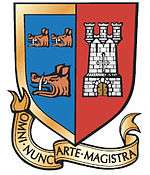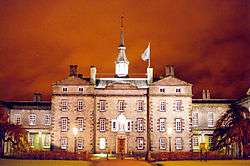Robert Gordon's College
Coordinates: 57°8′55″N 2°6′9″W / 57.14861°N 2.10250°W
 | |
| Motto | Omni nunc arte magistra which translates to 'Now Is The Time For All Of Your Masterly Skill" |
|---|---|
| Established | 1750 |
| Type | Independent day school |
| Head of College | Simon Mills |
| Head of Senior School | Andrea Angus, BSc, PGCE (to be succeeded by Mike Elder) |
| Chairman of the Governors | James Hutchison |
| Founder | Robert Gordon (philanthropist) |
| Location |
Schoolhill Aberdeen AB10 1FE Scotland |
| Local authority | Aberdeen City |
| Staff | 350 |
| Students | 1600~ |
| Gender | Coeducational |
| Ages | 3–18 |
| Houses | Blackfriars, Collyhill, Sillerton and Straloch |
| Colours | Navy and Gold |
| Publication | The Gordonian |
| Former pupils | Gordonians |
| Website |
www |
Robert Gordon's College is a private co-educational day school in the heart of Aberdeen, Scotland. The school caters for pupils from Nursery through to S6.
History
It originally opened in 1750 as the result of a bequest by Robert Gordon, an Aberdeen merchant who made his fortune from trading with Baltic ports, and was known at foundation as Robert Gordon's Hospital. This was 19 years after Gordon had died and left his estate in a 'Deed of Mortification' to fund the foundation of the Hospital. The fine William Adam-designed building was in fact completed in 1732, but lay empty until 1745 until Gordon's foundation had sufficient funds to complete the interior. During the Jacobite rising, in 1746 the buildings were commandeered by Hanoverian troops and named Fort Cumberland.
Gordon's aim was to give the poor boys of Aberdeen a firm education, or as he put it to "found a Hospital for the Maintenance, Aliment, Entertainment and Education of young boys from the city whose parents were poor and destitute". At this point all pupils at the school were boarders, but in 1881, the Hospital became a day school known as Robert Gordon's College. In 1903, the vocational education component of the college was designated a Central Institution (which was renamed as Robert Gordon's Institute of Technology in 1965 and became the Robert Gordon University in 1992). Boarding returned in 1937 with the establishment of Sillerton House. In 1989 RGC became a co-educational school.[1]
The modern school is divided into a Nursery, Junior School and Senior School, and caters for boys and girls from 3 to 18 years. Robert Gordon's College has long had a reputation as one of the strongest academic schools in Scotland, and follows the Scottish curriculum.
The Head of College, Simon Mills, is a member of Headmasters' and Headmistresses' Conference.
Arms and motto
The coat of arms shows the boar of the Gordon family, and a fort or keep on a red background. The latter is perhaps an allusion to the very similar coat of arms of the city of Hamburg, a founding member of the Hanseatic league of Baltic trading cities.
The Latin motto of the college, 'Omni nunc arte magistra' translates to 'Now is the time for all your masterly skill'; it is more commonly presented as 'Be The Best That You Can Be'.
House system
The school operates four houses, to one of which each student is allocated upon entering the school. The houses compete for different sporting and academic trophies throughout the year, and determine each senior school student's form class.
The four houses are:
- Blackfriars - named for the Dominican monks (or black friars due to their garb), that once had a convent adjacent to the school grounds.
- Collyhill - named for Alexander Simpson of Collyhill who bequeathed a large sum of money to the school, which allowed for more boys to join the school.
- Sillerton - The origin of the Sillerton house name is not clear, but it is believed that, in Robert Gordon's lifetime, he was known as Gordon of Silverton (siller being Scots for silver), and on a 1746 map, the school is identified as Sillerton Hospital.
- Straloch - named for Robert Gordon of Straloch, one of the first graduates of Marischal College, studying humanities, mathematics and philosophy.
Notable former pupils

Former pupils include:
- Ian Black was a Commonwealth Games gold medalist, and BBC Sports Personality of the Year in 1958 at the age of only seventeen. He later returned to RGC as Headmaster of the Junior School.
- Martin Buchan, former footballer and captain with Manchester United, Aberdeen and Scotland
- Sir Francisl Low, former editor of "The Times of India"
- Alan Pattillo, Film editor / Director / Producer worked on Gandhi 1982 and Thunderbirds amongst other work
- David Carry, Commonwealth gold medal winner
- John Macqueen Cowan FRSE, botanist
- Ernest Cruickshank and his twin brother Martin Melvin Cruickshank, surgeons
- Chris Cusiter, Ruaridh Jackson and Stuart Grimes, Scottish rugby players
- Martin Gilbert, founder and CEO, Aberdeen Asset Management
- Michael Gove, former journalist for The Times, MP for Surrey Heath (2005-present), Secretary of State for Education (2010-14), Government Chief Whip (2014-2015), and Lord Chancellor (2015-present).
- William "Buff" Hardie, of Scottish comedy act Scotland the What?[2]
- William Dickie Niven, theologian[3]
- BBC Radio Scotland presenter Robbie Shepherd
- Nicol Stephen, politician[4]
- Alastair Storey (born 1953), chairman and CEO of Westbury Street Holdings[5]
- Stewart Sutherland, Baron Sutherland of Houndwood, academic and public servant
- Robert A. Thom, steam locomotive engineer[6]
- Sandi Thom, singer[7]
- John West, Depute Provost of Aberdeen (elected at the age of 18).[8][9]
- Sir Ian Wood, Scottish businessman and Chancellor of the Robert Gordon University
- Ian Frazer, Key developer of the HPV vaccine
- Michael Benton FRS, vertebrate palaeontologist
- J. Michael Kosterlitz, awarded the 2016 Nobel Prize in Physics[10]
- Adele Merson, journalist at the Evening Express newspaper
- Andy McLaren, DC Thomson trainee journalist of the year 2015, breaking news reporter at the Evening Express newspaper
Former pupils' sports clubs
Gordonians RFC was originally founded by old pupils of the school. Former pupils also formed Gordonians Hockey Club and Gordonians Cricket Club. These clubs all play their home matches at the College's Countesswells Playing Field.
References
- ↑ "History of RGC". Rgc.aberdeen.sch.uk. Retrieved 2013-10-12.
- ↑ Webster, J. (2005) The Auld Hoose - The Story of Robert Gordon's College. ISBN 1-84502-051-0
- ↑ ‘NIVEN, William Dickie’, Who Was Who, A & C Black, an imprint of Bloomsbury Publishing plc, 1920–2007; online edn, Oxford University Press, Dec 2007 accessed 30 March 2014
- ↑ Nicol Stephen's MSP site
- ↑ http://www.scotsman.com/business/management/celebrity-toppling-alastair-storey-sees-catering-trade-as-table-laden-with-opportunity-1-2705414
- ↑ Marshall, John (1978). A Biographical Dictionary of Railway Engineers. Newton Abbot: David & Charles. p. 214. ISBN 0-7153-7489-3.
- ↑ "'97-'98 Class List". Rgc.aberdeen.sch.uk. Retrieved 2013-10-12.
- ↑ Councillor's Biography - John West
- ↑ Kirsty Scott (2007-06-13). "Guardian Unlimited - Fresh-faced challenge". London: Politics.guardian.co.uk. Retrieved 2013-10-12.
- ↑ Reference to J. Michael Kosterlitz as a former RGC pupil
External links
- Homepage of Robert Gordon's College
- Robert Gordon's College's page on Scottish Schools Online
- Robert Gordon's College bookplate on Footnote
- Profile on the ISC website
- HMIE Inspection Reports